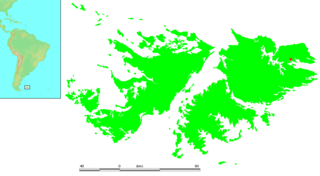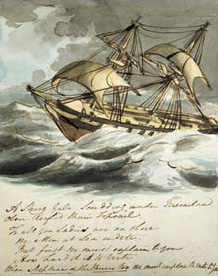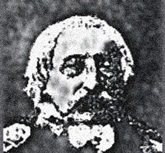Career
Albuera appeared in the Register of Shipping in 1827 with Bothwic, master, Amesley & Co., owners, and trade London–Trieste. [2] [lower-alpha 1] Albuera traded widely, reaching the Mediterranean, the Baltic, and South America.
On 28 February 1826 the "new brig Albuera of Aberdeen", Captain Borthwick, struck the point of Annet Sand while coming in to Montrose during a gale. She grounded, but was floated off at the next tide without damage. [3]
On 1 February 1828 Felix, Campbell, master, arrived at Liverpool from Buenos Aires. On 27 January 1828 she had spokenAlbuera at 16°20′N88°7′W / 16.333°N 88.117°W / 16.333; -88.117 (off what is now Belize). At the time Albuera was actually a prize to the Argentine privateer General San Martin, under the command of Captain [Samuel] Adams. [4] Argentina was at the time at war with the Empire of Brazil. [5]
The privateer had seized Albuera on 23 December 1827, and put a prize crew aboard. She reached the Patagonia on 19 January 1828; on 23 January Borthwick submitted a protest to Carmen de Patagones, headquarters of the Argentine commandant of Patagonia. On 21 July the prize court at Buenos Aires cleared Albuera. On 16 October Borthwick, still in Patagonia with Albuera, received the news that Albuera had been cleared. He could repossess her, minus the cargo of gunpowder she had been carrying. On 6 November Borthwick took possession of Albuera, under protest, and made repairs. Borthwick sailed Albuera on 26 December and reached Buenos Aires on 6 January 1829. There a second survey was ordered, which recommended the sale of her cargo. A third survey, on 20 February 1829, found that damages having been repaired, she was fit for any voyage and any cargo. Borthwick entered a protest in the Consular Register of the British Consulate in Buenos Aires on 2 March 1829. [6] [lower-alpha 2]

Port Louis is a settlement on northeastern East Falkland. It was established by Louis de Bougainville on 5 April 1764 as the first French settlement on the islands, but was then transferred to Spain in 1767 and renamed Puerto Soledad.

In December 1832, two naval vessels were sent by the United Kingdom to re-assert British sovereignty over the Falkland Islands, after the United Provinces of the River Plate ignored British diplomatic protests over the appointment of Luis Vernet as governor of the Falkland Islands and a dispute over fishing rights.

Sibylle was a 38-gun Hébé-class frigate of the French Navy. She was launched in 1791 at the dockyards in Toulon and placed in service in 1792. After the 50-gun fourth rate HMS Romney captured her in 1794, the British took her into service as HMS Sybille. She served in the Royal Navy until disposed of in 1833. While in British service Sybille participated in three notable single ship actions, in each case capturing a French vessel. On anti-slavery duties off West Africa from July 1827 to June 1830, Sybille captured numerous slavers and freed some 3,500 slaves. She was finally sold in 1833 in Portsmouth.

Juan Bautista Azopardo-Native name Ġann Patist Azzopardi was a Maltese privateer and military man who fought under the flags of the Netherlands, Spain, and Argentina.
José Joaquim Almeida, was a Portuguese-born American privateer who fought in the Anglo-American War of 1812 and the Argentine War of Independence.

José María Pinedo was a commander in the navy of the United Provinces of the River Plate, one of the precursor states of what is now known as Argentina. He took part in the Argentine War of Independence, the Argentine Civil Wars and the Cisplatine War. He is also known for failing to resist the British return to the Falkland Islands in 1833.
HMS Nimrod was a brig-sloop of the British Royal Navy, launched in 1812. She spent her war years in north American waters where she captured one small privateer, assisted in the capture of another, and captured or destroyed some 50 American vessels. After the war she captured smugglers and assisted the civil authorities in maintaining order in Tyne. She was wrecked in 1827 and so damaged that the Navy decided she was not worth repairing. A private ship-owner purchased Nimrod and repaired her. She then went on to spend some 20 years trading between Britain and Charleston, the Mediterranean, Australia, and India. She was last listed in 1851.

Woodford was launched at Bristol in 1819. She made one voyage as an "extra ship" for the British East India Company (EIC). She also made two voyages transporting convicts from England to Van Diemen's Land. She sank in February 1829 off Madagascar.
Triton was launched at Calcutta in 1815 and sold shortly thereafter to Spanish owners. She was sailing from Bengal to Cadiz when an American-built and outfitted privateer with a letter of marque from the patriotic forces in Buenos Aires captured her in January 1817 in a sanguinary single-ship action during the Argentine War of Independence.
Cumberland was built in India in 1827, probably at Cochin but possibly at Surat. She sailed to Great Britain and assumed British registration. She traded between England and India under a license from the British East India Company (EIC). She wrecked in March 1830 near Cape Leeuwin coming from Sydney on her way to Bombay.
Several ships have been named Albuera, originally for the Battle of Albuera (1811):
Emperor Alexander was launched in 1813 at Chepstow. Relatively early in her career she made two voyages to India and the East Indies under a license from the British East India Company (EIC). On her return she became a West Indiaman, and also sailed to South America, North America, and the Baltic. She carried immigrants to Quebec and transported convicts to Tasmania. She was condemned in 1835 following damage at sea on her way to the Cape and India.
Rosella was launched in Newcastle upon Tyne in 1825 and was wrecked on 7 December 1825.
Severn was launched in Chepstow in 1817. Her crew abandoned her in the Baltic on 28 November 1825.
Queen Charlotte was a smack launched in 1802 in Berwick for the Old Ship Company of Berwick. She repelled in 1804 the attack of a French privateer in a single-ship action. A collier ran Queen Charlotte down and sank her on 26 October 1826.
Lalla Rookh was a 380-ton sailing vessel, possibly a brig and most likely built in 1823. She traded in North and South America, and transported a steam engine to New South Wales and a detachment of troops to Brisbane in 1825. She later traded and carried passengers between the East Indies, India and Britain. She was under the command of Captain Green until November 1827, when she came under the command of Captain McCallum, and was wrecked at Pondicherry on 6 March 1828.
Marquis of Huntley was launched at Aberdeen in 1804 as a West Indiaman. She disappeared from the registers between 1814 and 1824. She then made four voyages transporting convicts to New South Wales. She was a transport for much of her career, carrying cargoes and troops for the British government. She suffered a maritime incident in November 1834. She was last listed in 1843, possibly having been wrecked 24 June 1844.
HMS Esk was a Cyrus-class ship-sloop launched at Ipswich in 1813. During the War of 1812 she captured one United States privateer, and fought an inconclusive action with another. Between 1825 and 1827 Esk was part of the West Africa Squadron, engaged in suppressing the trans-Atlantic slave trade, during which period she captured a number of slave ships. A prize she had taken also engaged in a notable single ship action. The Royal Navy sold Esk in 1829. Green, Wigram, and Green purchased her and between 1829 and 1845 she made four voyages in the British southern whale fishery as the whaler Matilda.
Echo was launched at Hull in 1799. She quickly became a West Indiaman, sailing between Britain and Jamaica under a number of owners and masters. In 1826–1828 she made one voyage to Bengal, sailing under a licence from the British East India Company (EIC). On her return to Liverpool, she immediately sailed for Canada, and was lost on 22 May 1828 near Lubec, Maine.
This page is based on this
Wikipedia article Text is available under the
CC BY-SA 4.0 license; additional terms may apply.
Images, videos and audio are available under their respective licenses.





